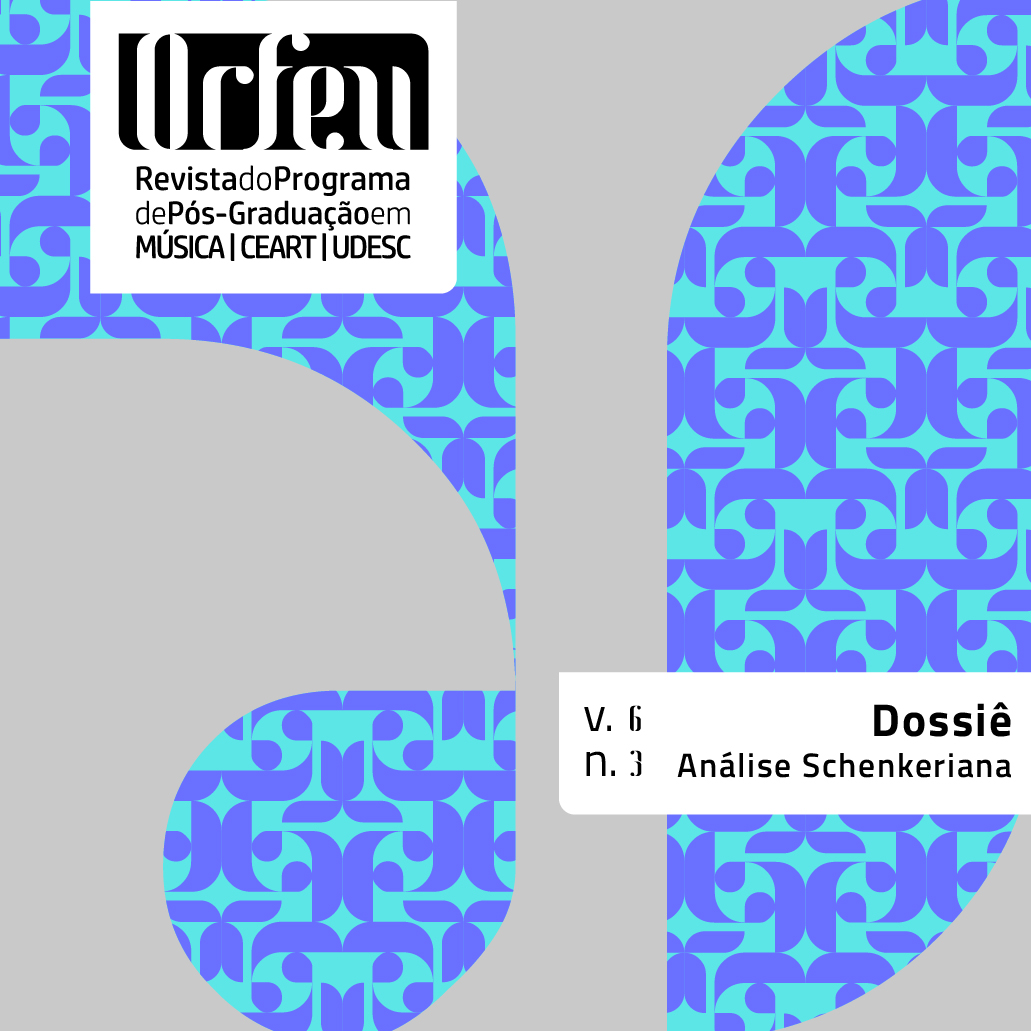Symmetry Relations in the Structure of Eu te amo, by Antonio Carlos Jobim and Chico Buarque de Holanda
DOI:
https://doi.org/10.5965/2525530406032021080Keywords:
Intervallic symmetry, Jobim and Chico Buarque, Schenkerian analysis in popular music, Relationship between text and musicAbstract
This article proposes a detailed analysis of the pitch structure of the song Eu te amo, composed by Antônio Carlos Jobim and Chico Buarque de Holanda, through the combined action of the Schenkerian methodology (properly adapted to the conditions of the object of study) and tools from the so-called Post-Tonal Theory. It aims to highlight the complex relationships of symmetry that characterize the piece, which involves the interaction of the interval classes 1, 5 and 6. After an analytical evaluation of the lyrics and the poetic form, which establishes a basis for the subsequent examination of the correlations between music and text, the article presents a discussion of the problems associated with the use of Schenkerian theory in post-tonal and popular music, supported by the literature on these subjects (STRAUS (1987), LERDAHL (1989), FORTE (1995), McGOWAN (2008), LARSON (1998; 2009), among others). The analysis that follows reveals the extraordinary symmetrical infrastructure (projected at different levels of organization) on which the song is built, which includes interactions with the poetic argument. In conclusion, although not perfectly adjusted to the models of the Schenkerian Ursatz, the complex and layered structure of the piece has its own logic, consistent in relation to examples of similar nature in the Jobinian work.
Downloads
References
ALMADA, Carlos (2009). Samba de uma nota só: elementos musicais a serviço da expressão poética. In: ENCONTRO ANUAL DA ANPPOM, 19., 2009, Curitiba. Anais […]. Curitiba: UFPR, 2009.
ALMADA, Carlos. Chovendo na roseira de Tom Jobim: Uma abordagem schenkeriana. Per Musi, n. 22, p. 99-106, 2010.
ALMADA, Carlos. A Ursatz jobiniana: considerações sobre aplicações da análise schenkeriana em estudos de música popular. In: CONGRESSO LATINOAMERICANO DE FORMACIÓN ACADÉMICA EM MÚSICA POPULAR, 3., Villa Maria, 2012. Anais […]. Villa Maria (Argentina), 2012. p. 1-10.
BUARQUE, Chico. Cancioneiro Chico Buarque: obras escolhidas. Rio de Janeiro: Jobim Music, 2008. 1 partitura. 2v.
EVERETT, Walter. The Beatles as Composers: The Genesis of Abbey Road, Side Two. In: MARVIN, Elisabeth. Concert Music, Rock, and Jazz Since 1945: Essays and Analytical Studies. Rochester: Rochester University Press, 1998. p. 172-258.
EVERETT, Walter. The Beatles as Musicians: The Quarry Men through Rubber Soul. Oxford: Oxford University Press, 2001.
FORTE, Allen. The American Popular Ballad of Golden Era, 1924-50. Princeton: Princeton University Press, 1995.
FORTE, Allen; GILBERT, Steven. Introduction to Schenkerian Analysis. New York: Norton, 1982.
GALLARDO, Cristóbal. Schenkerian analysis and popular music. Transcultural Music Review, n. 5, 2000. Disponível em: https://www.researchgate.net/publication/242626792_Schenkerian_Analysis_and_Popular_music. Acesso em: 30 set. 2020.
GILBERT, Steven. Gershwin’s Art of Counterpoint. Musical Quaterly, v. 70, n. 4, p. 423-456, 1984.
JOBIM, Tom. Songbook. Rio de Janeiro: Lumiar, 1995. 1 partitura. 3v.
JOBIM, Tom. Cancioneiro Jobim: obras escolhidas. Voz e piano. Rio de Janeiro: Jobim Music, 2006. 1 partitura. 5v.
LARSON, Steve. Schenkerian analysis of modern jazz: Questions about method. Music Theory Spectrum, v. 20, n. 2, p. 209-241, 1998.
LARSON, Steve. Analyzing Jazz: A Schenkerian Approach. New York: Pedragon, 2009. LERDAHL, Fred. Atonal Prolongational Structure. Contemporary Music Review, v. 4, n. 1, p. 65-87, 1989.
LERDAHL, Fred; JACKENDOFF, Ray. A Generative Theory of Tonal Music. Cambridge: The MIT Press, 1983.
LOVELL, Jeffrey. An Exploration of Melody, Harmony, and Improvisation in the Music of Stevie Wonder. Tese (PhD em Filosofia) – Universidade do Oregon, Eugene, 2012.
McFARLAND, Mark. Bill Evans and The Limits of Schenkerian Analysis. Journal of Schenkerian Studies, v. 6, p. 1-32, 2012.
McGOWAN, James. “Consonance” in Tonal Jazz: A Critical Survey of Its Semantic History. Jazz Perspectives. v. 2, n. 1, p. 69-102, 2008.
MORGAN, Robert. Dissonant Prolongation: Theoretical and Compositional Precedents.Journal of Music Theory. v. 20, n. 1, p. 49-91, 1976.
NOBILE, Drew. Counterpoint in Rock Music: Unpacking the “Melodic-Harmonic Divorce”. Music Theory Spectrum, v. 37, n. 2, p. 189-203, 2015.
PELLEGRIN, Richard. On Jazz Analysis: Schenker, Salzer, and Salience. Tese (PhD em Filosofia) – Universidade de Washington, Washington D.C., 2013.
SALZER, Felix. Structural Hearing: Tonal Coherence in Music. New York: Charles Boni, 1952.
SCHOENBERG, Arnold. Harmonia. Trad. Marden Maluf. São Paulo: Editora Unesp, 2001.
STRAUS, Joseph. The Problem of Prolongation in Post-Tonal Music. Journal of Music Theory, v. 31, n. 1, p. 1-21, 1987.
STRAUS, Joseph. Introduction to Post-Tonal Theory. 3. ed. Englewood Cliffs: Prentice-Hall, 2005.
STRUNK, Steven. Linear Intervallic Patterns in Jazz Repertory. Annual Review of Jazz Studies, v. 8, p. 63-115, 1996.
TYMOCZKO, Dmitri. A Geometry of Music: Harmony and Counterpoint in the Extended Common Practice. Oxford: Oxford University Press, 2011.
Downloads
Published
How to Cite
Issue
Section
License
Copyright (c) 2021 Carlos De Lemos Almada

This work is licensed under a Creative Commons Attribution 4.0 International License.
Authors who submit their manuscripts to be published in this journal agree to the following terms:
1. Authors retain the copyright and grant to the journal the right of first publication, whilst simultaneously permitting their work to be licensed under the Creative Commons License Attribution, which allows the sharing of work with recognition of the authorship and initial publication in this journal.
2. Contributions in this journal are open access; this means they are based in free use, and non-commercial applications.






